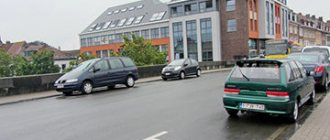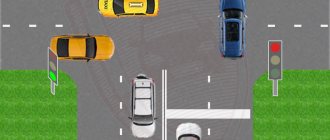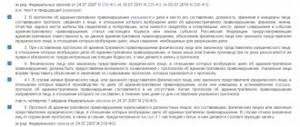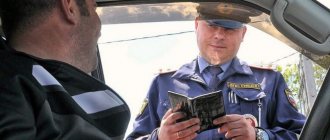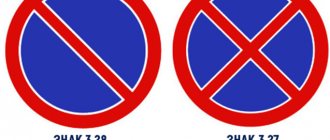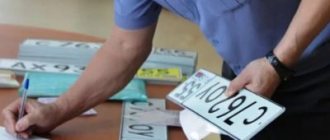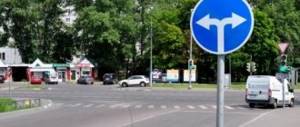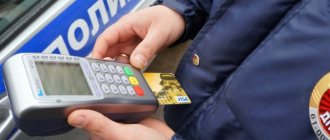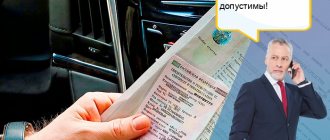What to do if you ignored the requirement by mistake
It happens that the driver simply does not notice the traffic police officer. This is possible at night or in fog.
If a fine is issued, a dashcam recording will help prove poor visibility. According to clause 65 of the Administrative Regulations of the Ministry of Internal Affairs, a traffic police officer must use a luminous or reflective baton and reflective clothing at night.
To appeal a fine, follow these steps:
- File a complaint addressed to the head of the department whose employee issued the fine. The department's contact details are in the fine order.
- Attach to the complaint a record from the registrar, which shows that it was difficult to notice the traffic police officer. Can be on a disk or flash drive.
- Send a complaint - with a personal visit or registered mail.
- Get the answer. The answer will be given in ten days.
Can a police officer stop a car without a baton - with his hand?
Yes, according to current legislation, the traffic controller has the right to stop the car with a hand gesture (clause 6.11 of the Russian Traffic Regulations). A traffic police officer can also use a baton and a whistle. This is also indicated by paragraph 85 of the Administrative Regulations of the Ministry of Internal Affairs No. 664, adopted on August 23, 2017.
That is, a police officer (traffic police inspector) has the right to demand that the car be stopped using the appropriate gesture. Therefore, you do not have the right to ignore the demands of a traffic police officer if he does not use a baton, whistle and other means. Accordingly, if you ignore the legal requirement to stop the vehicle, then you face direct liability under Article 12.25 of the Code of Administrative Offenses of the Russian Federation in the form of a fine in the amount of 500 to 800 rubles.
But how do you understand what kind of hand gesture a traffic police officer should make to stop a car? Unfortunately, the current legislation provides a vague formulation of the gesture for stopping vehicles. The law says that the gesture must be directed specifically at the vehicle that the police officer wants to stop for a document check or other procedural actions.
In principle, it is almost impossible not to notice a traffic police officer on the road. Unless, of course, you are distracted while driving, which is prohibited by current traffic regulations. Nevertheless, it is still possible not to notice the traffic police inspector. For example, in a large stream of cars when driving at high speed.
Also, many drivers often do not understand which of the road users is addressed by this or that gesture of the traffic police inspector. In this case, if you have doubts about which car the traffic police officer decided to stop, it is better to stop and clarify this point.
Is it worth returning to the employees if you have already passed
Alexander Torvard, auto lawyer
Sometimes the driver may not notice that the inspector has given a signal to stop and drives on. The inspector most likely will not catch up with you unless he suspects you of theft or drunk driving. You don't have to come back.
I can give you a case from practice. A man was driving along an unfamiliar road at night. He was given a sign to stop by a man whose shape resembled a traffic police officer, but there was no baton in his hand and there was no flashing light on the roof of the car. The man was afraid for his life and did not stop. It turned out that these were real traffic police officers, and they gave him a real fine. Later in court, the man explained why he did not stop. The court took into account his explanation and canceled the fine. In such cases, it is really better not to stop and not return - for your own safety.
Driver braking procedure
It is important to consider the procedure for stopping at the request of a traffic police officer. This process is described in sufficient detail in clause 6.11 of the current traffic rules. You should familiarize yourself with such sections at the very beginning of studying traffic rules.
The inspector needs to select the vehicle he is interested in and stop it in a certain place. To ensure the clarity of signals is unambiguous, a striped rod with built-in backlight or a disk indicator with a red reflector is used to identify them. Traffic police officers also often use whistles and special light and sound signals.
How, according to the regulations, a vehicle is stopped at the request of a traffic police officer
In paragraphs 85-87 of the special regulations for traffic police officers states that the inspector must give a signal to stop in one of the following ways:
- hand,
- with a rod,
- using a loudspeaker,
- using a whistle.
The traffic police inspector is obliged to take into account the safety of all other drivers on the road and cannot order to stop in a place that is dangerous for the driver or contrary to traffic rules.
Further actions of the inspector are described in paragraph 89 of the regulations. When stopping a vehicle, a traffic police officer must:
- approach the driver without delay;
- name the position, rank, first and last name;
- state the reason for the stop;
- request documents if deemed necessary;
- present a certificate at the request of the car owner;
- if you are going to detain the driver or his car, explain the reason, rights and obligations;
- if you plan to involve the driver or passengers as witnesses or witnesses, explain their rights and responsibilities.
Who, how and on what grounds can stop a vehicle?
It is important to always remember that traffic police officers have all the necessary rights to stop your car.
Can regular police officers ask you to stop your vehicle? Definitely yes, since they have broad powers to regulate traffic on the roads (clause 1. Chapter 2. Traffic Regulations).
Rules for stopping a vehicle by a traffic police inspector, watch the video:
2.1.1. Carry with you and, at the request of police officers, hand over to them for verification:
a driver's license or temporary permit to drive a vehicle of the appropriate category or subcategory; registration documents for this vehicle (except for mopeds), and if there is a trailer, also for the trailer, in established cases, permission to carry out activities for the transportation of passengers and luggage by passenger taxi, waybill, license card and documents for the transported cargo, and when transporting large, heavy and dangerous goods - documents provided for by the rules for transporting these goods; a document confirming the fact of disability, in the case of driving a vehicle on which the identification sign “Disabled” is installed ;insurance policy of compulsory civil liability insurance of the owner of a vehicle in cases where the obligation to insure one’s civil liability is established by federal law. In cases directly provided for by the legislation of the Russian Federation, have and submit for verification to employees of the Federal Service for Supervision of Transport a vehicle access card a means for carrying out international road transport, a waybill and documents for the transported cargo, special permits, in the presence of which, in accordance with the legislation on highways and road activities, the movement of a heavy and (or) large-sized vehicle, a vehicle carrying out transportation of dangerous goods, as well as provide a vehicle for weight and dimensional control.
A stop is usually carried out using a hand-held or stationary loudspeaker, a hand gesture, or a wand.
The inspector should clearly point to the selected vehicle, highlighting it from the traffic flow, at the same time sound a whistle and direct it to the side of the road. The driver, in turn, is obliged to leave the road, stopping at the indicated place.
What could be a reason to stop:
- signs of a driver violating traffic rules;
- suspicion of involvement of people in the transport in the crime;
- obvious signs of vehicle malfunction;
- a car similar to yours was caught violating traffic rules;
- you are required as an eyewitness to the crime;
- carrying out special operations initiated by the top management of the Ministry of Internal Affairs and the State Traffic Safety Inspectorate;
- identification, verification of vehicle documentation and documents for transported goods - carried out at checkpoints and traffic police posts.
What is the penalty for not stopping at the request of the inspector? Photo: olade.ru
What to do after stopping
Guided by paragraph 67 of Order No. 185 and Chapter 4 of Order of the Ministry of Internal Affairs No. 6, a traffic police representative is obliged to approach and introduce himself to the driver immediately after the vehicle stops, giving his full name, position, rank and clearly explaining why the car was stopped.
You don’t have to hand over documents - it’s enough to show them through the glass to prove your identity, and even more so, the inspector does not have the authority to force you to get out of the vehicle in order to proceed to the official car.
The requirement to leave the vehicle can only be made in the following cases:
- the need to eliminate vehicle malfunctions;
- sick or drunk driver;
- checking vehicle registration numbers in the presence of the driver;
- vehicle inspection;
- the people in the cabin pose a threat to the inspector and/or are wanted;
- the need to assist road users or traffic police officers.
If the driver does not stop at the request of the inspector, what is the punishment? Watch the video:
When can you ignore stop signals?
The car owner may not stop if the inspector demands to do so where the rules prohibit:
- on tram tracks;
- at railway crossings;
- if the road is already 3 meters, which means that a stopped car will block the passage for others;
- at pedestrian crossings and closer than 5 meters in front of them;
- if road visibility is less than 100 meters;
- closer than 5 meters from the intersection;
- closer than 15 meters from a public transport stop;
- if the car blocks the traffic light from other drivers;
- in the bike lane.
You also don’t have to brake after a “No Stopping” sign.
If the car owner did not brake in prohibited places and the inspector issued a fine, such a decision can be appealed and a record from the registrar can be attached.
Remember
- The punishment for the driver for not stopping is from 500 rubles to arrest for 15 days.
- If the car owner did not notice that the inspector was signaling to stop and he issued a fine, it can be appealed. Attach a recording from the registrar to the complaint, which shows that the inspector was invisible.
- The inspector may give chase if he considers that the driver is dangerous to other road users.
- The car owner may not stop if the rules prohibit doing so in the place where the inspector points.
All articles by the author: Evgeniy Lesnov
Fine
So, is it possible not to stop at the request of a traffic police inspector? Imagine the following situation: you are late for an important meeting, exceeding the speed limit, but suddenly you notice a traffic police officer who is diligently waving a “stick”, making it clear that you need to stop. But there won’t be an important meeting waiting for you, so you make a rash decision and press the gas pedal to the floor, increasing the speed and trying to hide from the sight of the vigilant employee.
But the inspector also has a bonus at stake! Therefore, he gets into a company car and goes after you (he has every right to do this). So, the traffic police officer caught up with you, what fine will you have to pay for disobedience?
The Code of Administrative Offenses provides for Chapter 12 of the Code of Administrative Offenses of the Russian Federation, which deals with administrative offenses in the field of road traffic. According to Part 2 of Art. 12.25, failure to comply with the legal requirements of a traffic police officer or an official of a federal executive body exercising control and supervision functions in the field of transport - refusal to stop at the required place - entails the imposition of an administrative fine in the amount of five hundred to eight hundred rubles.
It is clear from the legislative act that the fine can vary from 500 to 800 rubles. The final amount depends directly on the traffic police inspector, whose demands you ignored.
At first glance, the sanction is not that serious. But your rash decision to quickly hide can play a cruel joke on you. Since in this case, especially meticulous representatives of the traffic police may present you with the following article:
Part 1 art. 19.3 “Disobedience to a lawful order or demand of a police officer, a military serviceman or an employee of a body or institution of the penal system, or an employee of the National Guard of the Russian Federation in connection with the performance of their duties to protect public order and ensure public safety, as well as obstruction of the performance of official duties - entails imposition of an administrative fine in the amount of five hundred to one thousand rubles or administrative arrest for up to 15 days.”
Of course, such an outcome of events happens in rare cases, but nevertheless, in such a situation you will have to prove in court that Article 12.25 is a special (private) law in relation to Art. 19.3, therefore, it should be applied (Article 12.25).
